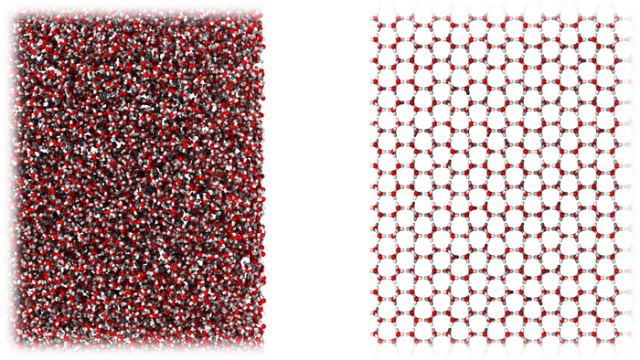If you thought ice varieties got no more interesting than crushed versus cubed, think again: Researchers have discovered an ice form whose haphazard molecular structure resembles that of liquid water, despite being a solid.
The peculiar ice, named medium-density amorphous ice (or MDA), also has a density similar to liquid water. Amorphous ice has been known before, but not at this middle ground for density. The researcher’s findings were published this week in Science.
“We know of 20 crystalline forms of ice, but only two main types of amorphous ice have previously been discovered, known as high-density and low-density amorphous ices,” said study co-author Christoph Salzmann, a materials scientist at University College London, in a Cambridge release.
“The accepted wisdom has been that no ice exists within that density gap,” Salzmann added. “Our study shows that the density of MDA is precisely within this density gap and this finding may have far-reaching consequences for our understanding of liquid water and its many anomalies.”
To find the loosely structured, Goldilocks-density ice, the team shook ordinary water ice in a jar crammed with steel balls, cooled to about -200 Celsius. The method is called ball milling and is a way of breaking up molecules using mechanical forces. The principle is simple: As the balls crash against the ice, the latter is pulverised. As a result, MDA looks like white powder; though it is a solid, it has the molecular composition of liquid water.
“We shook the ice like crazy for a long time and destroyed the crystal structure,” said Alexander Rosu-Finsen, a researcher at UCL and the study’s lead author, in the same release. “Rather than ending up with smaller pieces of ice, we realised that we had come up with an entirely new kind of thing, with some remarkable properties.”
With ice in the density gap, scientists will need to reevaluate the behaviour of water and water ice in different (in this case, extreme) conditions.
MDA had a final quirk: When the material recrystallized into ordinary water ice, it released a large amount of heat. The researchers believe the discovery could have geophysical implications for ice on the surfaces of frozen moons like Europa, to which NASA is scheduled to launch an orbiter in 2024.
“Amorphous ice in general is said to be the most abundant form of water in the universe,” said co-author Angelos Michaelides, a chemist at the University of Cambridge, in the release. “The race is now on to understand how much of it is MDA.”
The new research is just the latest to probe the nature of ice. Last year, a team of physicists used a diamond anvil to squish water ice into a tetragonal crystal structure, distinguishing the new ice (named Ice-VIIt) from the traditional hexagonal symmetry of water ice (known as Ice-I).
Hopefully, the discovery of such a mind-bending new form of ice will catalyze more research into how the abundant water form manifests across the universe. That’d be a rare instance of a good slippery slope.
More: Researchers Find ‘Forbidden’ Quasicrystal in Wake of Nuclear Bomb Test
